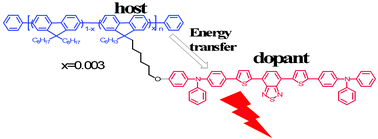Highly efficient red electroluminescent polymers with dopant/host system and molecular dispersion feature: polyfluorene as the host and 2,1,3-benzothiadiazole derivatives as the red dopant†
Abstract
By selecting polyfluorene as the polymer host, choosing 2,1,3-benzothiadiazole derivative moieties as the red dopant units and covalently attaching 0.3 mol% of the dopant units to the side chain of the polymer host, we developed a novel series of red electroluminescent polymers of dopant/host system with molecular dispersion feature. Their EL spectra exhibited predominant red emission from the dopant units because of the energy transfer and charge trapping from the polymer backbone to the dopant units. The emission wavelength of the polymers could be tuned by modifying the chemical structures of the dopant units. Single-layer devices (device configuration: ITO/PEDOT : PSS/polymer/Ca/Al) of these polymers emitted red light with a peak at 615 nm, a luminous efficiency of 5.04 cd A−1 and an external quantum efficiency of 3.47%, or emitted deep-red light with a peak at 650 nm, a luminous efficiency of 1.70 cd A−1 and an external quantum efficiency of 2.75%. Their high EL efficiencies were due to the energy transfer and charge trapping from the host to the dopant units as well as the molecular dispersion of the dopant units in the host. Increase of the dopant unit content led to increased turn-on voltages and decreased EL efficiencies of the resulting devices.


 Please wait while we load your content...
Please wait while we load your content...